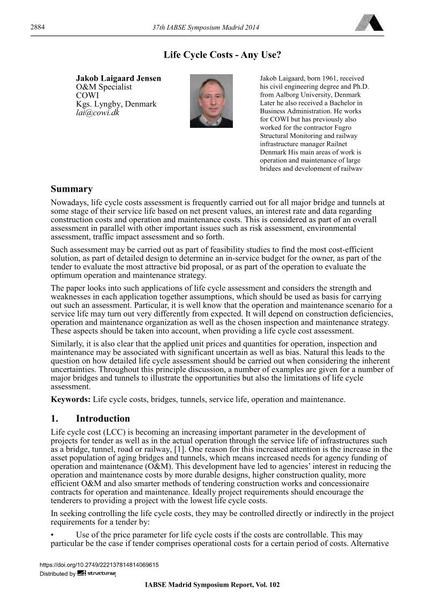Life Cycle Costs - Any Use?

|
|
|||||||||||
Bibliographic Details
| Author(s): |
Jakob Laigaard Jensen
|
||||
|---|---|---|---|---|---|
| Medium: | conference paper | ||||
| Language(s): | English | ||||
| Conference: | IABSE Symposium: Engineering for Progress, Nature and People, Madrid, Spain, 3-5 September 2014 | ||||
| Published in: | IABSE Symposium Madrid 2014 | ||||
|
|||||
| Page(s): | 2884-2892 | ||||
| Total no. of pages: | 9 | ||||
| Year: | 2014 | ||||
| DOI: | 10.2749/222137814814069615 | ||||
| Abstract: |
Jakob Laigaard, born 1961, received his civil engineering degree and Ph.D. from Aalborg University, Denmark Later he also received a Bachelor in Business Administration. He works for COWI but has previously also worked for the contractor Fugro Structural Monitoring and railway infrastructure manager Railnet Denmark His main areas of work is operation and maintenance of large bridges and development of railway Nowadays, life cycle costs assessment is frequently carried out for all major bridge and tunnels at some stage of their service life based on net present values, an interest rate and data regarding construction costs and operation and maintenance costs. This is considered as part of an overall assessment in parallel with other important issues such as risk assessment, environmental assessment, traffic impact assessment and so forth. Such assessment may be carried out as part of feasibility studies to find the most cost-efficient solution, as part of detailed design to determine an in-service budget for the owner, as part of the tender to evaluate the most attractive bid proposal, or as part of the operation to evaluate the optimum operation and maintenance strategy. The paper looks into such applications of life cycle assessment and considers the strength and weaknesses in each application together assumptions, which should be used as basis for carrying out such an assessment. Particular, it is well know that the operation and maintenance scenario for a service life may turn out very differently from expected. It will depend on construction deficiencies, operation and maintenance organization as well as the chosen inspection and maintenance strategy. These aspects should be taken into account, when providing a life cycle cost assessment. Similarly, it is also clear that the applied unit prices and quantities for operation, inspection and maintenance may be associated with significant uncertain as well as bias. Natural this leads to the question on how detailed life cycle assessment should be carried out when considering the inherent uncertainties. Throughout this principle discussion, a number of examples are given for a number of major bridges and tunnels to illustrate the opportunities but also the limitations of life cycle assessment. |
||||
| Keywords: |
bridges service life life cycle costs tunnel Operation and maintenance
|
||||
